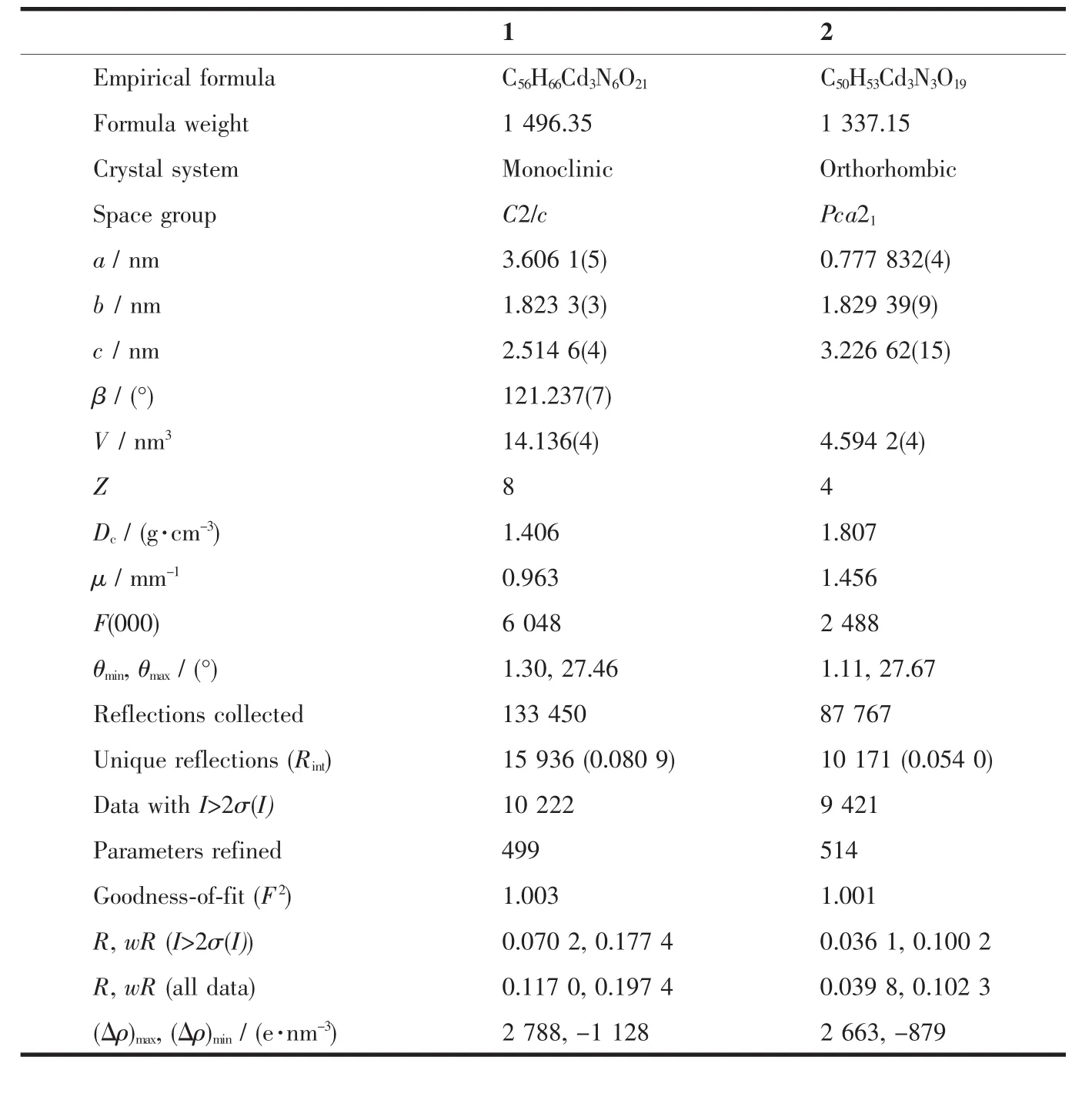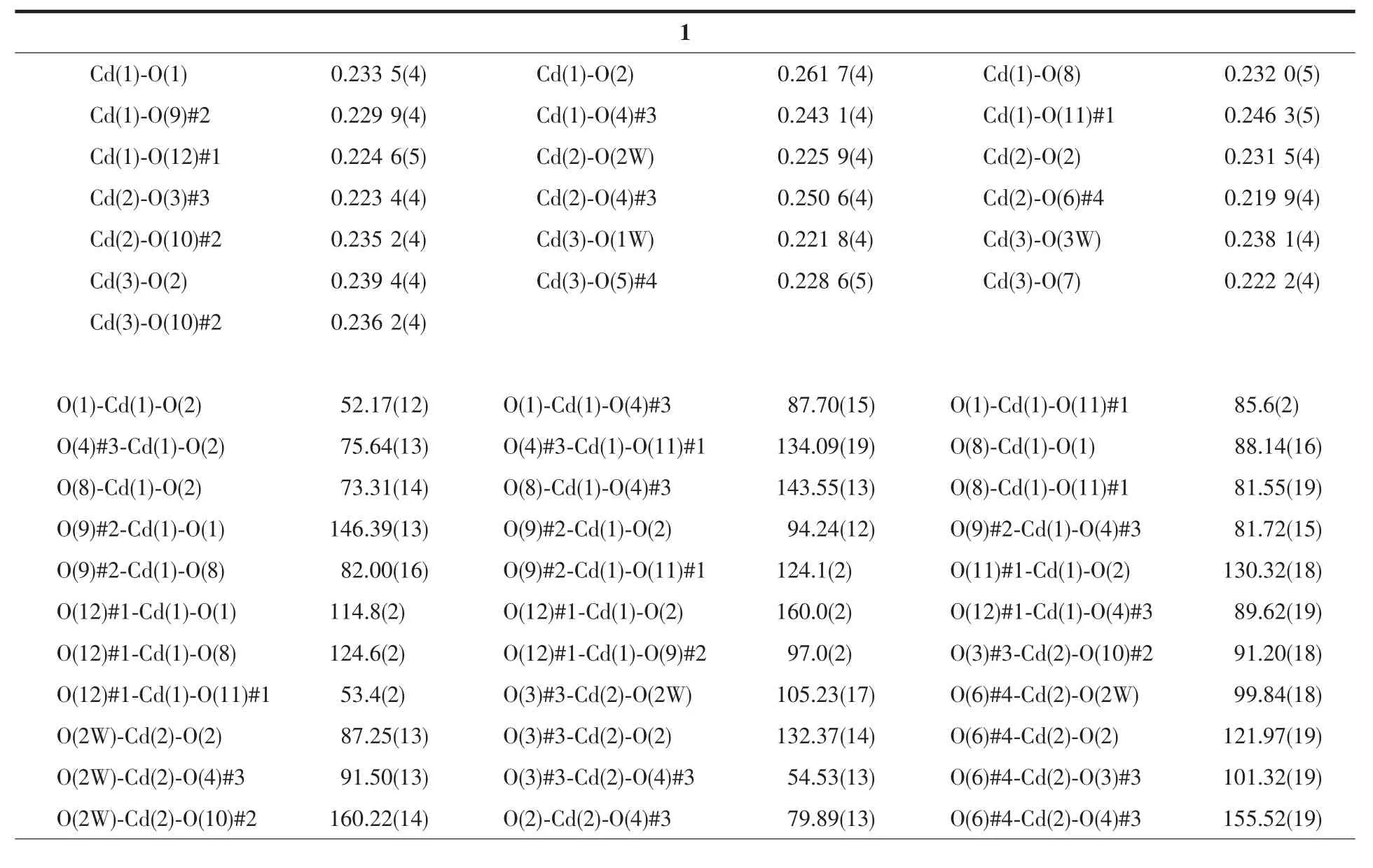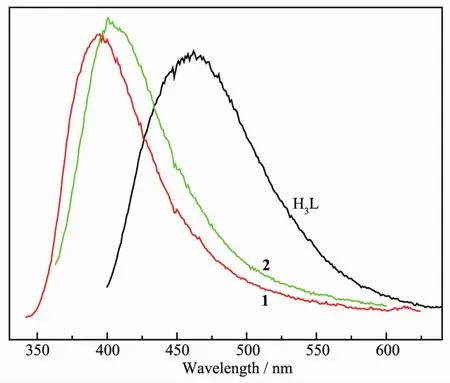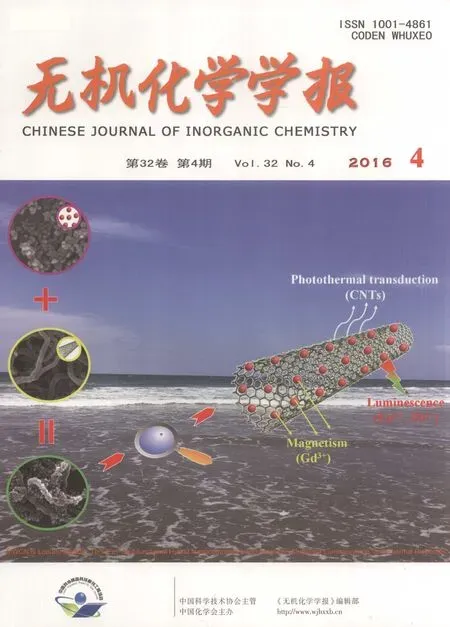以5-(6-羧酸-2-萘基)-间苯二羧酸为配体构筑的两个镉的金属-有机骨架化合物的合成、晶体结构及荧光性质
陈飞燕 蓝尤钊何亚兵 冯云龙
(浙江师范大学物理化学研究所,浙江省固体表面反应化学重点实验室,金华 321004)
以5-(6-羧酸-2-萘基)-间苯二羧酸为配体构筑的两个镉的金属-有机骨架化合物的合成、晶体结构及荧光性质
陈飞燕蓝尤钊*何亚兵冯云龙*
(浙江师范大学物理化学研究所,浙江省固体表面反应化学重点实验室,金华321004)
摘要:在溶剂热条件下,以不对称三羧酸5-(6-羧酸-2-萘基)-间苯二羧酸(H3L)为配体合成了2个镉的金属-有机骨架化合物:{[Cd3L2(H2O)3]·6DMF}n(1)和{[Cd3L2(H2O)4]·3DMA}n(2)。通过X射线单晶衍射,粉末衍射,热重和红外光谱进行了结构表征。结构分析表明,1和2形成3,6-连接的三维结构,其拓扑符号分别为:(45.64.86)(43)2和(6(12).83)(63)2。此外,还对2个化合物进行了荧光分析。
关键词:金属-有机骨架;不对称羧酸;晶体结构;拓扑结构;荧光性质
国家自然科学基金(No.1173197)资助项目。
*通信联系人。E-mail:sky37@zjnu.cn,lyzhao@zjnu.cn;会员登记号:S060017007(蓝尤钊),S06N0984M1401(冯云龙)。
0 Introduction
The last decades have witnessed rapid progress in the field of metal-organic frameworks (MOFs)[1], owing to intriguing architectures and topologies[2-4]and their potential applications in gas adsorption and separation, luminescence, catalysis, proton conductivity, magnetism, and so on[5-18]. Up to now, it is well known that large number of Cd-MOFs have been successfully obtained by using various carboxylate ligands[19-21].
To construct the new Cd-MOFs, we designed and synthesized a new unsymmetrical aromatic tricarboxylate organic ligand, namely, 5-(6-carboxynaphthalene-2-yl)isophthalic acid (H3L), as shown in Scheme 1. The organic ligand H3L was readily synthesized by a Pd-catalyzed Suzuki coupling between isophthalic acid and methyl 6-bromo-2-naphthoic acid followed bybase-catalyzed hydrolysis[22]. By using the H3L, two cadmium-organic frameworks, {[Cd3L2(H2O)3]·6DMF}n(1) and {[Cd3L2(H2O)4]·3DMA}n(2) have been solvothermally synthesized and characterized.

Scheme 1 Organic ligand H3L used to construct metal organic frameworks
1 Experimental
1.1 Materials and instrumentation
All of the chemical reagents were commercially available and used without further purication. The solvothermal reaction was performed in a 20 mL vial. Elemental analyses were performed on a Perkin-Elmer 2400Ⅱelemental analyzer. IR spectra were obtained from KBr pellets on a Nicolet 5DX FT-IR spectrometer. Powder X-ray diffraction (PXRD) data were obtained by placing the picked crystals onto the flat sample holders using a Philips PW3040/60 automated powder diffractometer with Cu Kα radiation (λ= 0.154 056 nm). Thermogravimetric analyses (TGA) were performed on a Netzsch STA449C analyzer with a heating rate of 5℃·min-1under a nitrogen atmosphere. The excitation and luminescence spectra were performed on a HITACHIF-2500 fluorescence spectrometer in solid state at room temperature. The diffraction data was collected on a Bruker APEXⅡdiffractometer equipped with a graphite-monochromatized Mo Kα radiation (λ=0.071 073 nm) at 296(2) K.
1.2 Syntheses of the compounds
1.2.1 Synthesis of {[Cd3L2(H2O)3]·6DMF}n(1)
A mixture of H3L (5.0 mg, 0.015 mmol) and Cd(NO3)2·4H2O (19.0 mg, 0.062 mmol) was dissolved in mixed solvent of 2.0 mL N,N-dimethyl formamide (DMF), the mixture was heated at 80℃for three days. The colourless block-shaped crystals were obtained and washed with DMF, dried in air with the yield of 80 % based on H3L. Anal. Calcd. for C56H66Cd3N6O21(%): C, 44.91; H, 4.41; N, 5.61. Found(%): C, 44.58; H, 4.85, N, 5.33. IR (KBr, cm-1): 1 663, 1 651, 1 629, 1 561, 1 544, 1 429, 1 390, 1 048, 783, 744, 719, 681. 1.2.2 Synthesis of {[Cd3L2(H2O)4]·3DMA}n(2)
A mixture of H3L (5.0 mg, 0.015 mmol) and Cd(NO3)2·4H2O (15.0 mg, 0.049 mmol) was dissolved in mixed solvent of 0.7 mL N,N-dimethyl acetamide (DMA), 0.7 mL H2O and 0.02 mL of an aqueous HClO4solution (2mol·L-1) at 80℃for four days. The colourless prism-shaped crystals were collected, washed with DMA and dried in air with the yield of 85% based on H3L. Anal. Calcd. for C50H53Cd3N3O19(%): C, 44.87; H, 3.96; N, 3.14. Found (%): C, 44.58; H, 3.65, N, 3.33. Selected infrared (KBr, cm-1): 1 668, 1 651, 1 634, 1582,1548,1429,1381,1219,779, 744, 723, 685.
1.3 Single-crystal structure determination
The diffraction data was collected on a Bruker APXEⅡdiffractometer up to a 2θ limit of 55.0°at 296(2) K. Data intensity was corrected by Lorentzpolarization factors and empirical absorption. The structure was solved by direct methods and refined using full matrix least-square techniques on F2with the program SHELXTL[23]. The solvent molecules are highly disordered therefore, the SQUEEZE routine of PLATON[24]was used to remove the diffraction contribution from these solvents to produce a set of solvent free diffraction intensities, the structure was then refined again using the data. The free solvent molecules were established on the basis of the reactants, singlecrystal X-ray diffraction studies, thermogravimetric analysis. Table 1 summaries crystal and structural refinement data and selected bond lengths and bond angles are shown in Table 2.
CCDC: 1431810, 1; 1431811, 2.
2 Results and discussion
2.1 Structure of {[Cd3L2(H2O)3]·6DMF}n(1)
Compound 1 crystallizes in the monoclinic space group C2/c. Besides the guest solvents, the asymmetric unit (Fig.1a) contains three crystallographically independent Cdions, two complete deprotonated ligands L3 -, three coordinated water molecules. Cd1 ion is coordinated to seven oxygen atoms from four chelating and three bridging carboxylates of five L3 -ligands to generate a distorted monocapped trigonalprism coordination geometry. Cd2 ion is coordinated to six oxygen atoms from three chelating and two bridging carboxylates of four L3-ligands and one water molecules to form a distorted octahedral geometry. Cd3 ion is coordinated to six oxygen atoms from four bridging carboxylates of four L3-ligands and two water molecules to form a distorted octahedral geometry. The Cd-Ocarboxylate distances vary from 0.219 9(4) to 0.261 7(4) nm, which are comparable to those reported[25-28]. Three Cdions are connected through five carboxylic groups to form a trinuclear [Cd3(COO)5] SBU. The SBUs are further connected by the L3-ligands to construct a 3D framework. Each organic L3-ligand links three trinuclear [Cd3(COO)5] SBUs and thus can be simplified as 3-conected node (Fig.1b). Each trinuclear SBU links six organic L3-ligands (Fig.1c) and can be considered as 6-connected node. The resulting network can be described as a (3,6)-connected net with Schlfli symbol of (45·64·86)(43)2(Fig.1d).

Table1 Crystal data and structure refinements for 1 and 2

Table2 Selected bond lengths (nm) and angles (°) for compounds 1 and 2

Continued Table 2
2.2 Structure of {[Cd3L2(H2O)4]·3DMA}n(2)

Fig.1 (a) Coordination environment of Cdions in 1; (b) L3-ligand viewed as 3-connected node; (c) Trinuclear Cd3(COO)5SBU viewed as 6-connected node; (d) View of the (3,6)-connected topological network

Fig.2 (a) Coordination environment of Cdions in 2; (b) L3-ligand viewed as 3-connected node; (c) Trinuclear Cd3(COO)4SBU viewed as 6-connected node; (d) View of the (3,6)-connected topological network
Compound 2 crystallizes in the orthorhombic space group Pca21. Besides the guest solvents, the asymmetric unit (Fig.2a) contains three crystallographically independent Cdions, two completely deprotonated L3-ligands, four coordinated water molecules. All Cdions are hexa-coordinated with distorted octahedral geometries. Cd1 ion is coordinatedto six oxygen atoms from three chelating and one bridging carboxylates of three L3-ligands and two water molecules. Cd2 ion is coordinated to six oxygen atoms from two chelating and two bridging carboxylates of three L3-ligands and two water molecules, and Cd3 ion is coordinated to six oxygen atoms from four bridging carboxylates of four L3-ligands and two water molecules. Three Cdpolyhedrons share vertexes (O2W, O3W) with each other generating a linear trinuclear [Cd3(COO)4] SBU. Topologically, each organic L3-ligand links three trinuclear SBUs (Fig.2b) and can be simplified as 3-connected node, while each trinuclear SBU links six organic L3-ligands (Fig.2c) and can be considered as 6-connected node. The network of 2 can be simplified as (3,6)-connected net with Schläfli symbol of (612·83)(63)2(Fig.2d).
2.3 Thermal analysis and PXRD results
The TGA curves show that both compounds exhibit the similar thermal behavior (Fig.3). For 1, the first weight loss of 29.11% in the temperature range of 35 ~200℃, which indicates the release of six lattice DMF (Calcd. 29.27%). The second weight loss of 4.09% occurred in the range of 200~330℃, which can be assigned to the loss of three coordinated water molecules (Calcd. 3.61%). Upon further temperature increases, the compound started to decompose slowly. For 2, the first weight loss of 20.09% in the range of 40 ~144℃attributed to loss of three lattice DMA (Calcd. 19.29%). The second weight loss of 5.45 % in the range of 144~305℃attributed to release of four coordinated water molecules (Calcd. 5.38%). Above 305℃, the frameworks began to decompose.

Fig.3 TGA curves of 1 and 2
The simulated and experimental PXRD patterns of Cd-MOFs are shown in Fig.4. The peak positions are in agreement with each other, indicating the phase purity of the as-synthesized products.

Fig.4 PXRD patterns of 1 and 2
2.4 Fluorescence properties
The fluorescence properties of the Cd-MOFs have been widely studied, in consideration of their potential applications as functional luminescent materials such as light-emitting diodes and luminescent probes[8,29]. Therefore, the photoluminescence spectra of free H3L ligand, 1 and 2 have been investigated in the solid state at room temperature. As shown in Fig.5, the free H3L ligand exhibits a broad emission band at 462 nm (λex=378 nm), which is ascribed to the intraligand ππ* transitions. The emission band of Cd-MOFs are similar to that of the free ligand, but obvious blueshift to 393 nm for 1 (λex=322 nm) and 400 nm for 2 (λex=357 nm) occur, which can probably be attributed to the decreased π-π inter-ligand interactions.

Fig.5 Solid-state emission spectra of H3L, 1 and 2
3 Conclusions
In summary, by using the new unsymmetrical tricarboxylate, 5-(6-carboxynaphthalen-2-yl)isophthalic acid (H3L), two (3,6)-connected Cd-MOFs have been solvothermally synthesized and characterized. 1 and 2 display blue luminescence in solid state. It is expected that the Cd-MOFs can use as luminescent materials for many fields in the future.
References:
[1] Zhu Q L, Xu Q. Chem. Soc. Rev., 2014,43:5468-5512
[2] Xu H, Zheng H G. Inorg. Chem. Commun., 2015,60:95-96
[3] Li M, Li D, O′Keeffe M, et al. Chem. Rev., 2014,114:1343-1370
[4] Zheng S T, Yang G Y. Dalton Trans., 2010,39:700-703
[5] He H M, Song Y, Sun F X, et al. Cryst. Growth Des., 2015, 15:2033-2038
[6] Fu H R, Wang F, Zhang J. Dalton Trans., 2014,43:4668-4673
[7] Huang Y M, Zheng X F, Duan J G, et al. Dalton Trans., 2014,43:6811-6818
[8] Seth S, Savitha G, Moorthy J N. Inorg. Chem., 2015,54:6829 -6835
[9] Su J, Yao L D, Zhao M, et al. Inorg. Chem., 2015,54:6169-6175
[10]Singh D, Nagaraia C. M. Cryst. Growth Des., 2015,15:3356-3365
[11]Wen L L, Xu X Y, Lü K L, et al. Appl. Mater. Interfaces, 2015,7:4449-4455
[12]Luo F, Batten S R. Dalton Trans., 2010,39:4485-4488
[13]Liu T F, Zhang W J, Sun W H, et al. Inorg. Chem., 2011, 50:5242-5248
[14]Zhang T , Lin W B. Chem. Soc. Rev., 2014,43:5982-5993
[15]Dang D B, Wu P Y, He C, et al. J. Am. Chem. Soc., 2010, 132:14321-14323
[16]Horike S, Umeyama D, Kitagawa S. Acc. Chem. Res., 2013, 46:2376-2384
[17]Li X, Sun H L, Wu X S. Inorg. Chem., 2010,49:1865-1871
[18]Zhang C Q, Sun L B, Li J Y, et al. Dalton Trans., 2015,44: 230-236
[19]Wu Y L, Yang G P, Zhao Y Q, et al. Dalton Trans., 2015, 44:3271-3277
[20]Yu M H, H M, Wu Z T. RSC Adv., 2013,3:25175-25183
[21]WANG Xiao-Xiao(王晓晓), LIU Yong-Guang(刘永光), GE Ming(葛明), et al. Chinese J. Inorg. Chem.(无机化学学报), 2015,31:2065-2072
[22]Chen F Y, Ling Y J, Song C L, et al. Eur. J. Inorg. Chem., 2016:503-508
[23]Sheldrick G M. SHELXTL-97, Program for the Refinement of Crystal Structures, University of Göttingen, Germany, 1997.
[24]Spek A L. Acta Cryst., 2009,D65:148-155
[25]ZHAI Chang-Wei(翟长伟), CHENG Mei-Ling(程美令), HAN Wei(韩伟), et al. Chinese J. Inorg. Chem.(无机化学学报), 2015,31:1409-1416
[26]Li B, Dai X M, Meng X G, et al. Dalton Trans., 2013,42: 2588-2593
[27]Zhang X P, Zhou J M, Shi W, et al. CrystEngComm, 2013, 15:9738-9744
[28]Luo L, Chen K, Liu Q, et al. Cryst. Growth Des., 2013,13: 2312-2321
[29]Yi F Y, Yang W T, Zhong M S. J. Mater. Chem., 2012,22: 23201-23209
Two Cadmium-Organic Frameworks Constructed from 5-(6-Carboxynaphthalen-2-yl) isophthalic Acid: Syntheses, Crystal Structures and Fluorescence Properties
CHEN Fei-Yan LAN You-Zhao*HE Ya-Bing FENG Yun-Long*
(Zhejiang Key Laboratory for Reactive Chemistry on Solid Surfaces, Institute of Physical Chemistry; Zhejiang Normal University, Jinhua, Zhejiang 321004, China)
Abstract:Two cadmium-organic frameworks based on a new tricarboxylate ligand, 5-(6-carboxynaphthalen-2-yl) isophthalic acid (H3L), {[Cd3L2(H2O)3]·6DMF}n(1) and {[Cd3L2(H2O)4]·3DMA}n(2), have been solvothermally synthesized and characterized by single-crystal X-ray diffraction, powder X-ray diffraction, TGA and FTIR. 1 and 2 feature a 3D (3,6)-connected net with Schlfli symbol of (45.64.86)(43)2and (6(12).83)(63)2, respectively. Furthermore, the luminescent properties of 1 and 2 were investigated. CCDC: 1431810, 1; 1431811, 2.
Keywords:cadmium-organic frameworks; unsymmetrical tricarboxylate; crystal structure; topological structure; luminescence property
收稿日期:2015-10-27。收修改稿日期:2016-01-14。
DOI:10.11862/CJIC.2016.085
中图分类号:O614.24+2
文献标识码:A
文章编号:1001-4861(2016)04-0699-07

